New Software Review: RX 6 Noise Reducer from iZotope
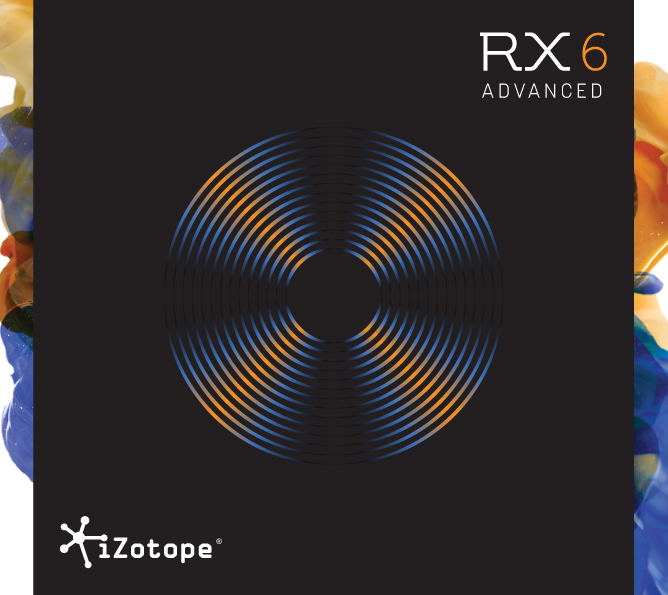
With the addition of several new and powerful modules, RX 6 is surely the most expansive and comprehensive iteration of the RX series iZotope has yet to offer.
iZotope is an undisputed champion of creative audio tools for music and post-production. Their products allow users of every skill level to tackle the most challenging sonic obstacles with relative ease and speed, and always produce spectacular-sounding results.
I’ve written extensively in the past about many of iZotope’s offerings. Today, we’re going to be focusing specifically on RX 6 and its wealth of new features and additions.
If you are new to RX, I would recommend you start by reading my reviews of RX 3 and RX 5. These detail some of the groundbreaking modules that debuted in the earlier versions of the RX suite, such as Dialogue De-Noiser (now improved and re-named Voice De-Noise), Leveler, De-Plosive, Module Chain and many more.
Features
iZotope has added several new modules and features to RX 6, making it an even more comprehensive and impressive suite of tools than its earlier iterations. Some of these new additions include De-Rustle, De-Wind, Di
RX 6 can be used as a standalone audio editor connected to your host via RX Connect, or as a suite of plugins. Information on system requirements, supported operating systems, plugin hosts, and plugin formats can be found here on iZotope’s website.
RX 6 is available in four different tiers, each of which is designed to accommodate the unique needs of musicians and post production professionals of all levels. RX Elements is the most bare-bones of the four, available for $129, RX Standard for $399, and RX Advanced for $1,199. RX 6 is also available as part of RX Post Production Suite 2 for $1,499.
The tools in the RX line are without question the ones that I use most often on audio-post projects. Lately, I’ve been splitting my time between documentary and film work, as well as editing and mixing podcasts like Here’s The Thing and The West Wing Weekly.
As I did for my RX 5 review, we’ll be talking with L.A.-based audio-post mixer Lawrence Everson to get his take on some of the new modules in RX 6. Lawrence recently mixed the spectacular feature documentary “A River Below,” which I had the pleasure of screening at the Tribeca Film Fest. (I highly recommend you check this film out if you get the chance.)
Before we begin, one note on connectivity and efficiency: the relationship between RX and your DAW is made possible by the Connect plugin, which allows you to select one or many audio clips in your DAW and send it to and from the standalone RX app for maximum processing ability and ease of use. Connect first debuted in RX 4 and has really become the cornerstone of the relationship between RX and my DAW.
Note: All modules labeled “(ADV)” indicate that it is an advanced version feature only.
As for all of the new features found in RX 6, let’s dig in!
In Use
De-Rustle (ADV): This is easily one of the most asked-for additions to the RX module set by its user base. Simply enough, De-Rustle is designed to snipe out rustle noises typically created by lavalier mics rubbing against clothing. The noise profile for a rustle sound is often very complex and can run the spectrum from top end crackle to low end rumble, making it one of the most challenging and frustrating types of noise to deal with.
As with many of the RX tools, the De-Rustle module is very simple to use. Two sliders for Reduction Strength and Ambience Preservation make up the entire GUI, along with some general presets. Ambience Preservation incorporates elements of the Ambience Match module to help preserve clean background noise while removing unwanted rustle noise. How does this work? iZotope’s preview video for De-Rustle explains:
“We collected lots of isolated [noises] rustle which we then used to corrupt clean speech and feed to a machine learning algorithm trained to recover the clean speech. When processing, the trained machine learning algorithm separates the clean speech from the background rustle.”
All this to say, De-Rustle works. And it works very well.
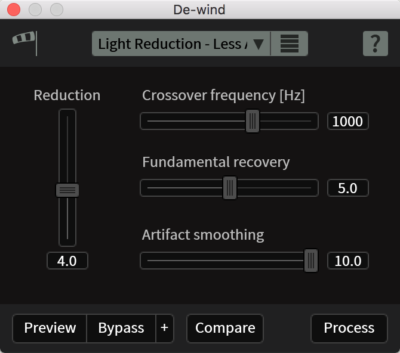 De-Wind (ADV): De-Wind is another brilliant addition to the RX 6 toolkit for tackling one of the most common production audio issues—wind noise.
De-Wind (ADV): De-Wind is another brilliant addition to the RX 6 toolkit for tackling one of the most common production audio issues—wind noise.
De-Wind accomplishes with a single click what was once a tedious task in the Spectral Repair module, saving me tons of precious time over the course of a given project.
Sliders for Crossover Frequency, Fundamental Recovery and Artifact Recovery (as well as a General Reduction slider) make up the main controls.
Overall, De-Wind performs exactly as you would expect. The module quickly and easily removes low end subharmonic wind rumble from dialogue and production tracks while retaining the structure and integrity of the original recording.
That said, De-Wind does require a bit of experimentation to find the sweet spot. There’s a threshold in terms of reduction level where the processed audio can begin to sound too filtered or thin. By and large, De-Wind performed perfectly and saved me lots of time when processing complex outdoor audio for the feature documentary “Not a War Story” that I’ve been mixing for director Tim O’ Donnell. Take a listen to De-Wind in action here.
Dialogue Isolate (ADV): Dialogue Isolate is a beast. As described by iZotope, “[It is] is designed to separate spoken dialogue from non-stationary background noise such as crowds, traffic, footsteps, weather, or other noise with highly variable characteristics.”
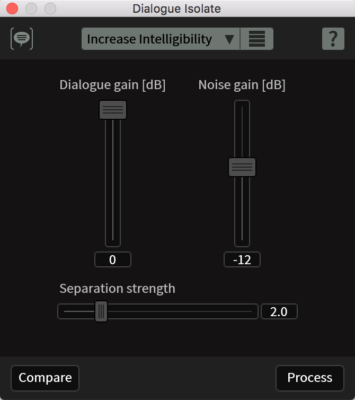 This is a truly remarkable plugin that I’m constantly finding new uses for. Again, very simple parameters for Dialogue Gain, Noise Gain and Separation Strength give you clear and simple control over this extremely powerful module.
This is a truly remarkable plugin that I’m constantly finding new uses for. Again, very simple parameters for Dialogue Gain, Noise Gain and Separation Strength give you clear and simple control over this extremely powerful module.
My colleague Lawrence Everson was also able to put Dialogue Isolate to the test. Lawrence notes, “One common documentary problem I often face is voices recorded in crowds, conventions, protests, or other issues where a human voice is within a sea of other human voices. This is something very tricky to tame.
“While it’s not a miracle worker, I was impressed more often than not at what Dialogue Isolate could do, especially versus the previous broadband noise reduction modules. I found gentle passes had surprisingly helpful separation, and even intense passes would be helpful for forensic or translation situations where you simply need to hear what is being said in a noisy space.”
Check out iZotope’s breakdown of Dialogue Isolate here.
Mouth De-Click: This is bar-none one of my most-used modules in podcasting work, and anything else where dialogue and voice are crucial elements of the production. Mouth De-Click improves upon what I used to use De-Crackle for; it utilizes a completely separate algorithm from De-Crackle for processing specifically the tiny cracks and clicks created by mouth noises from dialogue.
I had some questions about the differences between De-Crackle and Mouth De-Click, which iZotope engineers happily answered for me. Most notably, Mouth De-Click is optimized for standalone mouth noises (with short or long intervals in between), versus De-Crackle, which is optimized for continuous noise. It is designed to handle mouth noises that range from clicks to smacks to watery sounds, and works many times faster than De-Crackle. It is lower latency, and caters specifically to frequencies in the voice/vocal range.
While De-Crackle and Mouth De-Click can often provide similar results, I’ve found Mouth De-Click to be faster overall and a better, more focused module for making close mic dialogue sound spectacularly clean and polished.
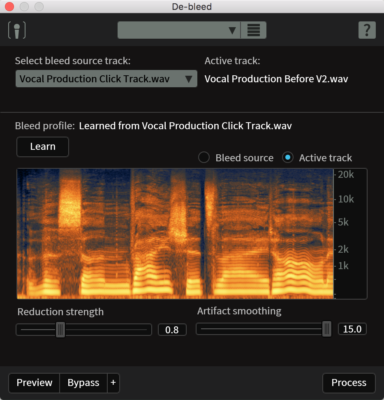 De-Bleed: De-Bleed is used to reduce bleed from one track or one mic to another. The release of this module was practically a jump-up-and-down, happy-cry moment for me and likely many other engineers who have dealt with these issues before.
De-Bleed: De-Bleed is used to reduce bleed from one track or one mic to another. The release of this module was practically a jump-up-and-down, happy-cry moment for me and likely many other engineers who have dealt with these issues before.
While iZotope has made great progress with regard to bleed issues in their Spectral Repair tool, De-Bleed creates an entirely new purpose-built solution to one of the most detrimental tracking problems in music production.
The most obvious use for De-Bleed is click track bleed from a vocalist’s headphones into their vocal mic or perhaps an acoustic guitar mic. It requires two sync’d tracks: the bleed source and the active track.
With a bit of “learning,” RX 6 can then process the unwanted bleed sound completely out of the active track with truly stunning results. I wasn’t able to put De-Bleed to the test on any of my current projects, but take a look at this full length demo of the De-Bleed module and see for yourself just how remarkable this tool is.
Two other modules worth mentioning that have been extremely useful to me in the podcast world are De-Ess and Breath Control. Both of these perform just as you would expect, and provide surgical control over two of the most problematic areas of voice recordings.
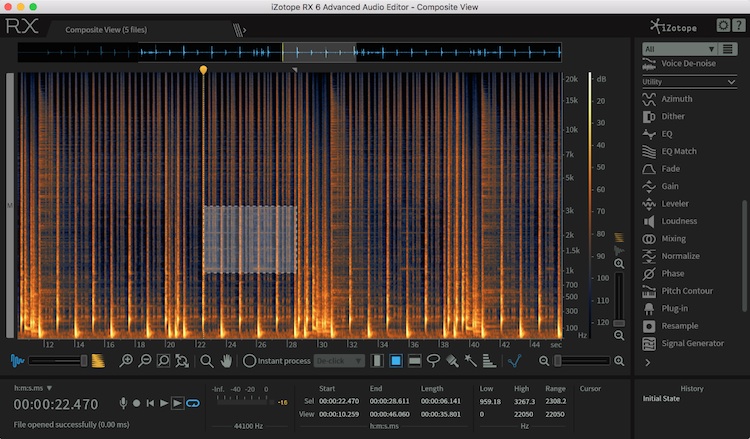
With the addition of Composite View, you can now repair several sound sources at once, proving to be one of the many new time saving features of RX 6.
Another exciting new feature of RX 6 is Composite View. Lawrence and I had similar experiences with this new feature, which provides a long-awaited solution for multichannel processing.
Lawrence explains, “I’ve long wished for RX to be able to handle 5.1 and other multichannel audio as easily as it handles stereo files. While we’re not completely there yet in RX 6, we are a step closer with [iZotope’s] new Composite View, which I absolutely love. It collapses down multiple tracks into one spectral repair window, allowing you to select and edit all of them simultaneously, after which you can expand them back out again.
“I found this immensely useful for things like surround ambiance recordings with bird chirps that needed to be edited out, which before was a tedious process as each channel had to be individually spectral-repaired one at a time. Now I can collapse all the spectrographs together into the composite form, select and edit out the bird chirps once, then un-collapse them all and re-render the repaired files. This feature alone saves a ton of time. It’s also very handy for multiple-mic setups, where you can edit out common sound problems across all the open channels at once.
“My dream would still be for RX to someday open quad and 5.1 files in the same fashion it opens and displays stereo files, but even then the Composite View functionality would still be beneficial. This is a great new feature.”
More information on Composite View is available here.
There are also a few other excellent additions to RX 6 that help increase productivity. The new Module List Filters tool, for example, allows me to set up different groups of modules that I use more often than others, depending on the project. I have separate lists for Podcast, Film and Music Mixing that help me group the most-used modules for quick and easy access.
Lawrence notes, “Overall, many of the new features serve to speed up or refine processes and save on mouse clicks—something that can easily pay dividends over the course of a project. A lot of the new modules are for specific things I used to have to dive into the spectral repair window to try and fix, and now there are quicker and easier methods to attack the noise problems… or at least more avenues of attack that are open to exploration or combination. And anything that saves time on intensive manual tasks is welcome on film and TV projects where turnarounds are tight but the demand for clean and good quality audio is high.”
To Be Critical
As mentioned above, true multichannel support is still at the top of my wishlist for future incarnations of RX. Composite View is a great step in that direction, however it would also be nice to see the Instant Process selection feature provide access to more modules instead of just the five it currently offers (Attenuate/De-Click/
Summing It Up
With RX 6, iZotope continues to expand upon what was already one of the best-value audio production suites on the market. It is an absolute must-have set of tools in my personal arsenal. It’s also encouraging to see iZotope listen to their user community and expand their products to suit the needs of those work with them every day!
RX 6 is all about efficiency, and with the wealth of newly added features, I’m able to accomplish the task at hand, return my audio to Pro Tools and move on with incredible speed. I’m continually impressed with the new modules iZotope creates for the RX suite, all of which are sure to make every audio-post engineer’s job easier and less stressful. Well done iZotope!
Zach McNees is a Brooklyn-based producer/engineer/mixer and live recordist whose work includes Björk, Rob Thomas, The Gregory Brothers, Pixies, and many more. Zach’s post-production work includes House Hunters International (HGTV), VICE (HBO), All-American Makers (Science Channel) and the award winning documentary short “For The Love of Dogs”. Get in touch with Zach at http://www.zachmcnees.com.
Please note: When you buy products through links on this page, we may earn an affiliate commission.






